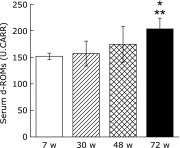Relationship between hyposalivation and oxidative stress in aging mice
- PMID: 28751808
- PMCID: PMC5525015
- DOI: 10.3164/jcbn.16-79
Relationship between hyposalivation and oxidative stress in aging mice
Abstract
The increase in oxidative stress that accompanies aging has been implicated in the abnormal advance of aging and in the onset of various systemic diseases. However, the details of what effects the increase in oxidative stress that accompanies aging has on saliva secretion are not known. In this study, naturally aging mice were used to examine the stimulated whole saliva flow rate, saliva and serum oxidative stress, antioxidant level, submandibular gland H-E staining, and immunofluorescence staining to investigate the effect of aging on the volume of saliva secretion and the relationship with oxidative stress, as well as the effect of aging on the structure of salivary gland tissue. The stimulated whole saliva flow rate decreased significantly with age. Also, oxidative stress increased significantly with age. Antioxidant levels, however, decreased significantly with age. Structural changes of the submandibular gland accompanying aging included atrophy of parenchyma cells and fatty degeneration and fibrosis of stroma, and the submandibular gland weight ratio decreased. These results suggest that oxidative stress increases with age, not just systemically but also locally in the submandibular gland, and that oxidative stress causes changes in the structure of the salivary gland and is involved in hyposalivation.
Keywords: aging; hyposalivation; oxidative stress; salivary gland.
Conflict of interest statement
No potential conflicts of interest were disclosed.
Figures





Similar articles
-
Hyperoxia reduces salivary secretion by inducing oxidative stress in mice.Arch Oral Biol. 2019 Feb;98:38-46. doi: 10.1016/j.archoralbio.2018.11.001. Epub 2018 Nov 2. Arch Oral Biol. 2019. PMID: 30445238
-
Impact of aging on human salivary gland function: a community-based study.Aging (Milano). 1998 Oct;10(5):421-8. doi: 10.1007/BF03339889. Aging (Milano). 1998. PMID: 9932146
-
Beta-adrenergic receptors and salivary gland secretion during aging.Growth Dev Aging. 1992 Winter;56(4):215-23. Growth Dev Aging. 1992. PMID: 1336769
-
The physiology of salivary secretion.Periodontol 2000. 2016 Feb;70(1):11-25. doi: 10.1111/prd.12116. Periodontol 2000. 2016. PMID: 26662479 Review.
-
Effect of photic stimuli on rat salivary glands. Role of sympathetic nervous system.Acta Odontol Latinoam. 2000;13(1):3-19. Acta Odontol Latinoam. 2000. PMID: 11885465 Review.
Cited by
-
Peroxisomes Are Highly Abundant and Heterogeneous in Human Parotid Glands.Int J Mol Sci. 2023 Mar 1;24(5):4783. doi: 10.3390/ijms24054783. Int J Mol Sci. 2023. PMID: 36902220 Free PMC article.
-
Assessment of Salivary Flow Rate in Patients with Chronic Periodontitis.J Pharm Bioallied Sci. 2020 Aug;12(Suppl 1):S308-S312. doi: 10.4103/jpbs.JPBS_92_20. Epub 2020 Aug 28. J Pharm Bioallied Sci. 2020. PMID: 33149477 Free PMC article.
-
Smad7 attenuates TGF-β-mediated aging-related hypofunction of submandibular glands.Exp Biol Med (Maywood). 2021 Jun;246(11):1269-1273. doi: 10.1177/1535370221993430. Epub 2021 Feb 27. Exp Biol Med (Maywood). 2021. PMID: 33641444 Free PMC article.
-
Extracellular matrix turnover in salivary gland disorders and regenerative therapies: Obstacles and opportunities.J Oral Biol Craniofac Res. 2023 Nov-Dec;13(6):693-703. doi: 10.1016/j.jobcr.2023.08.009. Epub 2023 Sep 12. J Oral Biol Craniofac Res. 2023. PMID: 37719063 Free PMC article.
-
Whey Protein Concentrate WPC-80 Improves Antioxidant Defense Systems in the Salivary Glands of 14-Month Wistar Rats.Nutrients. 2018 Jun 17;10(6):782. doi: 10.3390/nu10060782. Nutrients. 2018. PMID: 29914217 Free PMC article.
References
-
- Gueiros LA, Soares MS, Leão JC. Impact of ageing and drug consumption on oral health. Gerodontology. 2009;26:297–301. - PubMed
-
- Nagler RM. Salivary glands and the aging process: mechanistic aspects, health-status and medicinal efficacy monitoring. Biogerontology. 2004;5:223–233. - PubMed
-
- Locker D, Matear D, Stephens M, Jokovic A. Oral health-related quality of life of a population of medically compromised elderly people. Community Dent Health. 2002;19:90–97. - PubMed
-
- Baker SR, Pankhurst CL, Robinson PG. Utility of two oral health-related quality-of-life measures in patients with xerostomia. Community Dent Oral Epidemiol. 2006;34:351–362. - PubMed
LinkOut - more resources
Full Text Sources
Other Literature Sources

